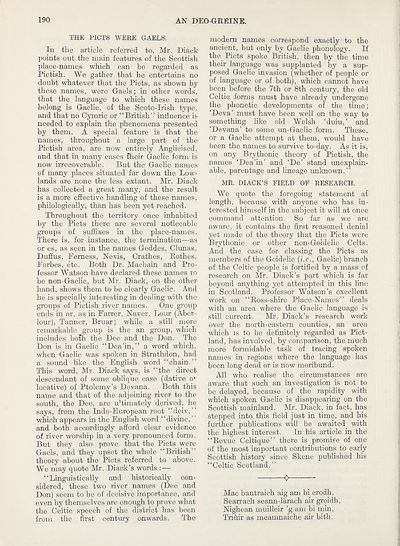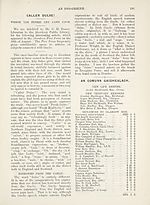An Comunn Gàidhealach Publications > Deo-gréine > Volume 16, October 1920-September 1921
(198) Page 190
Download files
Complete book:
Individual page:
Thumbnail gallery: Grid view | List view

190
AN DEO-GREINE.
THE PICTS WERE GAELS.
In the article referred to, Mr. Diack
points out the main features of the Scottish
place-names which can be regarded as
Pictish. We gather that he entertains no
doubt whatever that the Piets, as shown by
these names, were Gaels; in other words,
that the language to which these names
belong is Gaelic, of the Scoto-Irish type,
and that no Cymric or “British” influence is
needed to explain the phenomena presented
by them. A special feature is that the
names, throughout a large part of the
Pictish area, are now entirely Anglicised,
and that in many cases Qieir Gaelic form is
now irrecoverable. But the Gaelic names
of many places situated far down the Low¬
lands are none the less extant. Mr. Diack
has collected a great many, and the result
is a more effective handling of these names,
philologically, than has been yet reached.
Throughout the territory once inhabited
by the Piets there are several noticeable
groups of suffixes in the place-names.
There is, for instance, the termination—as
or es, as seen in the names Geddes, Clunas,
Duffus, Ferness, Nevis, Crathes, Rothes,
Forbes, etc. Both Dr. Macbain and Pro¬
fessor Watson have declared these names to
be non-Gaelic, but Mr. Diack, on the other
hand, shows them to be clearly Gaelic. And
he is specially interesting in dealing with the
groups of Pictish river names. One group
ends in ar, as in Farrer, Naver, Lour (Aber-
lour), Tanner, Bruar; while a still more
remarkable group is the an group, which
includes bom the Dee and the Don. The
Don is in Gaelic “Dea’in,” a word which,
when Gaelic was spoken in Strathdon, had
a sound like the English word “chain.”
This word, Mr. Diack says, is “the direct
descendant of some oblique case (dative o'-
locative) of Ptolemy’s Devana. Both this
name and that of the adjoining river to the
south, the Dee, are u’timately derived, he
says, from the Indo-European root “deiv,”
which appears in the English word “divine,
and both accordingly afford clear evidence
of river worship in a very pronounced form.
But they also prove that the Piets were
Gaels, and they upset the whole “British”
theory about the Piets referred to above.
We may quote Mr. Diack’s words : —
“Linguistically and historically con¬
sidered, these two river names (Dee and
Don) seem to be of decisive importance, and
even by themselves are enough to prove what
the Celtic speech of the district has been
from the first century onwards. The
modem names correspond exactly to the
ancient, but only by Gaelic phonology. If
the Piets spoke British, then by the time
their language was supplanted by a sup¬
posed Gaelic invasion (whether of people or
of language or of both), which cannot have
been before the 7th or 8th century, the old
Celtic forms must have already undergone
the phonetic developments of the time;
‘Deva’ must have been well on the way to
something like old Welsh ‘duiu,’ and
‘Devana’ to some un-Gaelic form. These,
or a Gaelic attempt at them, would have
been the names to survive to-day. As it is,
on any Brythonic theory of Pictish, the
names ‘Dea’in’ and ‘De’ stand unexplain¬
able, parentage and lineage unknown. ”
MR. DIACK’S FIELD OF RESEARCH.
We quote the foregoing statement at
length, because with anyone who has in¬
terested himself in the subject it will at once
command attention. So far as we are
aware, it contains the first reasoned denial
yet made of the theory that the Piets were
Brythonic or other non-Goidelic Celts.
And the case for classing the Piets as
members of the Goidelic (i.e., Gaelic) branch
of the Celtic people is fortified by a mass of
research on Mr. Diack’s part which is far
beyond anything yet attempted in this line
in Scotland. Professor Watson’s excellent
work on “Ross-shire Place-Names” deals
with an area where the Gaelic language is
still current. Mr. Diack’s research work
over the north-eastern counties, an area
which is to be definitely regarded as Pict-
land, has involved, by comparison, the much
more formidable task of tracing spoken
names in regions where the language has
been long dead or is now moribund.
All who realise the circumstances are
aware that such an investigation is not to
be delayed, because of the rapidity with
which spoken Gaelic is disappearing on the
Scottish mainland. Mr. Diack, in fact, has
stepped into this field just in time, and his
further publications will be awaited with
the highest interest. In his article in the
“Revue Celtique” there is promise of one
of the most important contributions to early
Scottish history since Skene published his
“Celtic Scotland.”
0
Mac bantraich aig am bi crodh,
Searrach seann-larach air greidh,
Nighean muilleir ’g am bi min,
Triuir as meamnaiche air bith.
AN DEO-GREINE.
THE PICTS WERE GAELS.
In the article referred to, Mr. Diack
points out the main features of the Scottish
place-names which can be regarded as
Pictish. We gather that he entertains no
doubt whatever that the Piets, as shown by
these names, were Gaels; in other words,
that the language to which these names
belong is Gaelic, of the Scoto-Irish type,
and that no Cymric or “British” influence is
needed to explain the phenomena presented
by them. A special feature is that the
names, throughout a large part of the
Pictish area, are now entirely Anglicised,
and that in many cases Qieir Gaelic form is
now irrecoverable. But the Gaelic names
of many places situated far down the Low¬
lands are none the less extant. Mr. Diack
has collected a great many, and the result
is a more effective handling of these names,
philologically, than has been yet reached.
Throughout the territory once inhabited
by the Piets there are several noticeable
groups of suffixes in the place-names.
There is, for instance, the termination—as
or es, as seen in the names Geddes, Clunas,
Duffus, Ferness, Nevis, Crathes, Rothes,
Forbes, etc. Both Dr. Macbain and Pro¬
fessor Watson have declared these names to
be non-Gaelic, but Mr. Diack, on the other
hand, shows them to be clearly Gaelic. And
he is specially interesting in dealing with the
groups of Pictish river names. One group
ends in ar, as in Farrer, Naver, Lour (Aber-
lour), Tanner, Bruar; while a still more
remarkable group is the an group, which
includes bom the Dee and the Don. The
Don is in Gaelic “Dea’in,” a word which,
when Gaelic was spoken in Strathdon, had
a sound like the English word “chain.”
This word, Mr. Diack says, is “the direct
descendant of some oblique case (dative o'-
locative) of Ptolemy’s Devana. Both this
name and that of the adjoining river to the
south, the Dee, are u’timately derived, he
says, from the Indo-European root “deiv,”
which appears in the English word “divine,
and both accordingly afford clear evidence
of river worship in a very pronounced form.
But they also prove that the Piets were
Gaels, and they upset the whole “British”
theory about the Piets referred to above.
We may quote Mr. Diack’s words : —
“Linguistically and historically con¬
sidered, these two river names (Dee and
Don) seem to be of decisive importance, and
even by themselves are enough to prove what
the Celtic speech of the district has been
from the first century onwards. The
modem names correspond exactly to the
ancient, but only by Gaelic phonology. If
the Piets spoke British, then by the time
their language was supplanted by a sup¬
posed Gaelic invasion (whether of people or
of language or of both), which cannot have
been before the 7th or 8th century, the old
Celtic forms must have already undergone
the phonetic developments of the time;
‘Deva’ must have been well on the way to
something like old Welsh ‘duiu,’ and
‘Devana’ to some un-Gaelic form. These,
or a Gaelic attempt at them, would have
been the names to survive to-day. As it is,
on any Brythonic theory of Pictish, the
names ‘Dea’in’ and ‘De’ stand unexplain¬
able, parentage and lineage unknown. ”
MR. DIACK’S FIELD OF RESEARCH.
We quote the foregoing statement at
length, because with anyone who has in¬
terested himself in the subject it will at once
command attention. So far as we are
aware, it contains the first reasoned denial
yet made of the theory that the Piets were
Brythonic or other non-Goidelic Celts.
And the case for classing the Piets as
members of the Goidelic (i.e., Gaelic) branch
of the Celtic people is fortified by a mass of
research on Mr. Diack’s part which is far
beyond anything yet attempted in this line
in Scotland. Professor Watson’s excellent
work on “Ross-shire Place-Names” deals
with an area where the Gaelic language is
still current. Mr. Diack’s research work
over the north-eastern counties, an area
which is to be definitely regarded as Pict-
land, has involved, by comparison, the much
more formidable task of tracing spoken
names in regions where the language has
been long dead or is now moribund.
All who realise the circumstances are
aware that such an investigation is not to
be delayed, because of the rapidity with
which spoken Gaelic is disappearing on the
Scottish mainland. Mr. Diack, in fact, has
stepped into this field just in time, and his
further publications will be awaited with
the highest interest. In his article in the
“Revue Celtique” there is promise of one
of the most important contributions to early
Scottish history since Skene published his
“Celtic Scotland.”
0
Mac bantraich aig am bi crodh,
Searrach seann-larach air greidh,
Nighean muilleir ’g am bi min,
Triuir as meamnaiche air bith.
Set display mode to:
![]() Universal Viewer |
Universal Viewer | ![]() Mirador |
Large image | Transcription
Mirador |
Large image | Transcription
| An Comunn Gàidhealach > An Comunn Gàidhealach Publications > Deo-gréine > Volume 16, October 1920-September 1921 > (198) Page 190 |
|---|
| Permanent URL | https://digital.nls.uk/125656363 |
|---|
| Description | Leabhar 16, Mìos Deireannach an Fhogharaidh 1920 gu Darna Mìos an Fhoghair 1921 |
|---|---|
| Attribution and copyright: |
|
| Description | This contains items published by An Comunn, which are not specifically Mòd-related. It includes journals, annual reports and corporate documents, policy statements, educational resources and published plays and literature. It is arranged alphabetically by title. |
|---|
| Description | A collection of over 400 items published by An Comunn Gàidhealach, the organisation which promotes Gaelic language and culture and organises the Royal National Mòd. Dating from 1891 up to the present day, the collection includes journals and newspapers, annual reports, educational materials, national Mòd programmes, published Mòd literature and music. |
|---|---|
| Additional NLS resources: |
|

